Many beachcombers come across unusual finds at the beach without even knowing it. Seaglass is an amazing find in itself, but finding a piece of glass that glows under UV light is something extraordinary.
Amongst all of the normal pieces of sea glass that we find, you can also be lucky enough to find a material called uranium glass or UV glass as most beachcombers call it.
This type of glass will glow under a black light and is definitely a sight to witness. This glass is also rarer than normal sea glass and you might not come across it as often. It is definitely something to be aware of so that if you do find it, you will know all about its unique qualities.
What to expect from our article
- 1 What is Uranium?
- 2 What is Uranium Glass?
- 3 What is Vaseline Glass?
- 4 What does uranium glass look like?
- 5 How Can You Tell if Glass is Uranium?
- 6 How to Identify Uranium Without a Black light
- 7 Is Uranium Glass Dangerous?
- 8 How Much is Uranium Glass Worth?
- 9 Can You Drink Out of Uranium Glass?
- 10 Why Did They Use Uranium in Glass?
- 11 Is it Safe to Wear Uranium Glass Jewelry?
- 12 Where Can I Find Uranium Glass?
What is Uranium?
Uranium is a heavy metal that has been used throughout history for a multitude of different reasons. It occurs in most rocks of concentrations of 2 to 4 parts per million. It also occurs in seawater and can be recovered from the ocean. It is said to have been discovered by a German chemist, who named it after the planet Uranus, which had been discovered eight years earlier.
It is thought that uranium was formed in a supernovae around 6.6 billion years ago and it has a melting point of 1132 degrees Celsius.
What is Uranium Glass?
Uranium glass is a type of glass that has uranium, usually in the form of oxide diuranate, added to the mixture before melting. This process adds colour to the glass. Usually, the trace levels of uranium are at around 2%, but in some glass pieces from the 20th century, up to 25% of the material is made up of uranium.
Uranium glass was made for a variety of reasons and was often used for tableware and household items. Uranium stopped being used as often after the Cold War and glass containing uranium is now considered to be an antique collectible.
Uranium glass is sometimes used for art glassware, but it is now mostly used for smaller objects like beads or marbles. The novelty of the glass makes for unique decoration.
During the depression, iron oxide was added to the glass to further increase its glowing green colour.
There are different colour variants of uranium glass, but the coloured versions aren’t always made with uranium, so you should check if you are unsure. They should always glow bright green under UV light and if it doesn’t, it isn’t uranium glass.
What is Vaseline Glass?
The most common type of uranium glass in one that is a pale yellowish green colour. This glass was nicknamed ‘Vaseline glass’. This is because it resembled the colour of Vaseline petroleum jelly, as it was at the time.
Vaseline glass can sometimes have an oily sheen to it. It is also generally translucent, but this isn’t always the case.
Uranium glass is glass of any colour that contains uranium. Vaseline glass is a variant of uranium glass that is only yellow in colour. Vaseline glass does still glow under UV light.
What does uranium glass look like?
Uranium glass is typically yellow or green in colour, but this depends on the level of oxidation and the concentration of the metal ions. The colouring could also be modified with the use of glass colourants, so it can be found in other colours, it is just more unlikely.
This type of glass will fluoresce bright green when it is held under an ultraviolet light. Fluorescence is caused by substances in the glass that absorb the ultraviolet light and then release it as visible light and heat.
How Can You Tell if Glass is Uranium?
The easiest way to tell if your glass is uranium glass is to expose the glass to ultraviolet light using something called a black light. A black light is a light that emits ultraviolet light. If the glass glows a bright green glowing colour, then it contains uranium.
There are sometimes exceptions to this rule, and some uranium glass doesn’t actually glow under UV light. The yellow ‘gemstone’ glass will not fluoresce even though it contains uranium. There can also be glass with depleted levels of uranium that may only glow in certain areas.
How to Identify Uranium Without a Black light
If you hold your glass up to the sunlight, you should be able to detect a faint glow. This means that your glass is, in fact, uranium glass.
Is Uranium Glass Dangerous?
Uranium glass can register above background radiation on a Geiger counter, but most pieces of this glass are only slightly radioactive, making them harmless. It usually only contains trace amounts of uranium, which means that it is about as radioactive as a fire alarm.
How Much is Uranium Glass Worth?
The value of the type of glass is very dependent on where it was made and how rare the individual piece is. Genuine items from the 19th century are valued highly and well sought after. This means that they are worth more. Fragments of glass aren’t typically valuable, but they do make a nice addition to your collection.
Can You Drink Out of Uranium Glass?
Yes, you can as it only contains trace amounts of uranium and usually doesn’t register as dangerous when using a Geiger counter. In this instance, you can drink out of uranium glass tumblers. As it is only used as a colourant, the uranium cannot contaminate your water as it cannot penetrate through the glass and into the drink. If you are unsure, you can test the glass using a Geiger counter.
Why Did They Use Uranium in Glass?
The use of uranium glass dates back to 79 AD. A mosaic containing uranium was found in a Roman villa in Italy. More recently, during the mid-1800s, uranium became widely used in glass making and it became really popular. It was used to make uniquely coloured glass.
During World War I, uranium became a heavily regulated substance after new laws were created. Deregulation occurred in 1958, but the uranium glass that was produced after this period wasn’t the same as it was before. They began to use depleted uranium that wasn’t as radioactive as the type that was previously used.
Interestingly, production of uranium ceased during World War II in America, and they confiscated all supplies of uranium glass. These restrictions were later lifted, but they started to use a lower grade uranium in more limited quantities.
Is it Safe to Wear Uranium Glass Jewelry?
In the later Victorian era, it was really common for it to be used in beads and jewelry. Whilst uranium isn’t commonly used today, it is safe to wear as jewelry. There are occasionally very old pieces of uranium that can contain higher levels of radiation, so it is important to be knowledgeable of the material that you are using.
Some collectors actually own Geiger counters so that they can measure the levels of radioactivity in the glass to make sure that it is safe. If you are planning on using your finds to make and sell uranium jewelry, it might be a good idea to purchase a Geiger counter so that you know your products are completely safe. It may be unlikely for your uranium glass to be dangerous, but it is still a very slight possibility, and it’s better to be on the safe side.
Where Can I Find Uranium Glass?
Uranium glass is a very specific and unique type of glass that beachcombers everywhere would love to get their hands on so that they can add it to their collection. Just like ordinary sea glass, uranium glass can be found scattered among beaches all over the UK. You won’t be able to find it at every beach, but you may be lucky enough to come across some at beaches where sea glass is more commonly located. You can look at our list of the best beachcombing beaches.
Uranium glass can end up on beaches due to how people used to dispose of their glass waste before environmentalism was a concern. Companies would dump their glass over the edges of cliffs and other locations, and years later it started to wash up on beaches everywhere as the sea glass that we find today.
There are also bottle dump locations that are hidden all over the place and are just waiting to be stumbled across. You can still find full bottles or fragments in these places and may even be lucky enough to come across uranium glass.
Some beachcombers may have already come across it without even knowing it. It can sometimes blend in with your other finds and you could pick it up without even realising. It might be worth checking through your collections at home to see if you do have any.
You can take a black light with you to the beach to help you identify uranium glass, or you can hold it up to the sunlight to see if it has a faint glow.

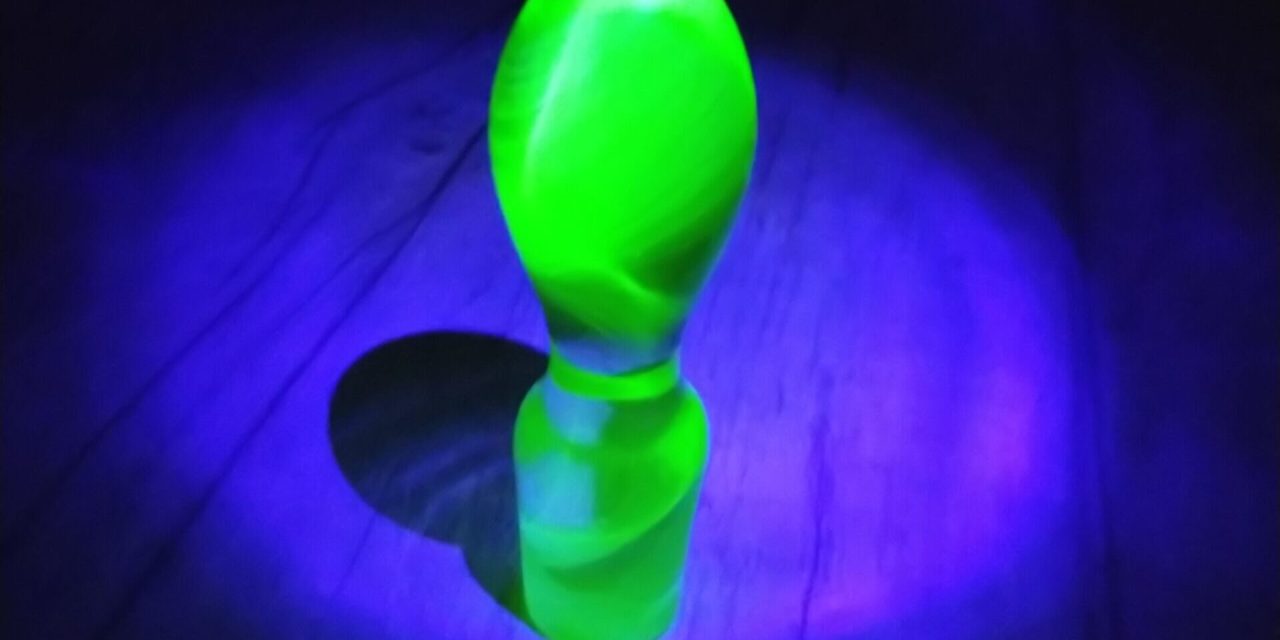
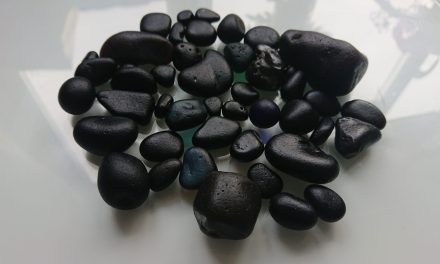

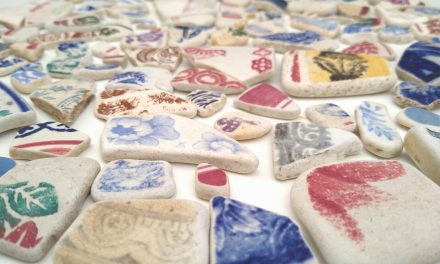



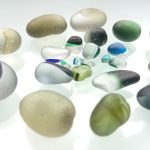



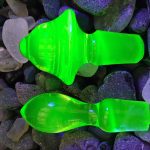
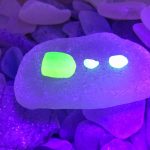


Trackbacks/Pingbacks